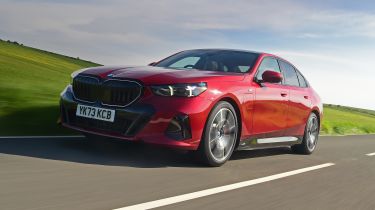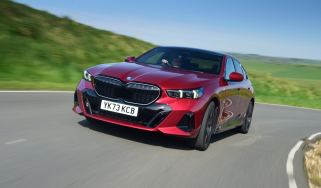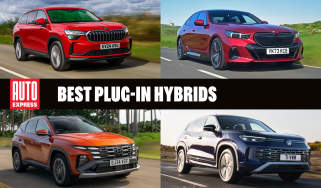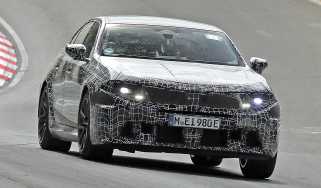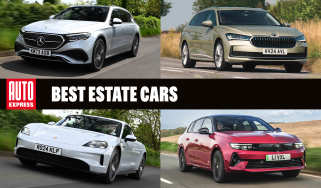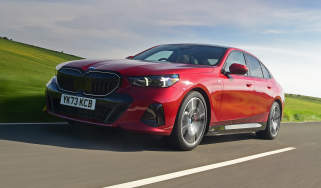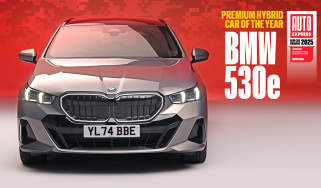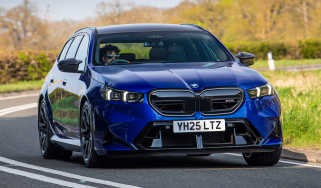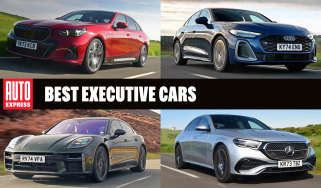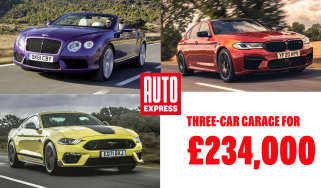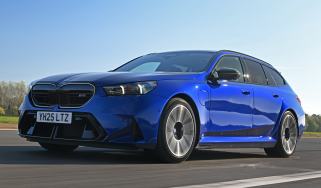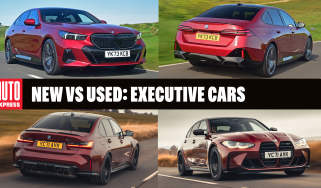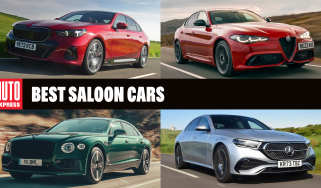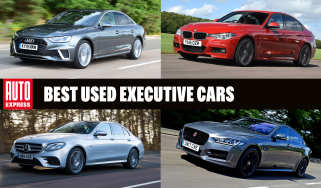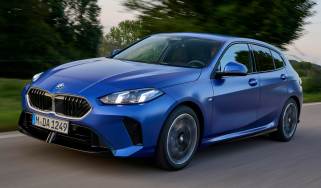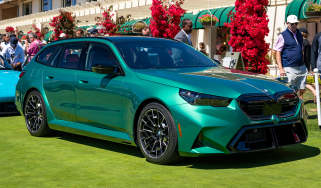BMW 5 Series review
The BMW 5 Series goes large on technology and electrification, but the keen dynamics of the previous model remain

Quick review
Once again, the latest BMW 5 Series is a staggeringly capable all-rounder. Comfortable, great to drive, and wonderfully luxurious inside, there are very few flaws to find anywhere.
The only real sticking point is that the highly impressive all-electric BMW i5 is only slightly more expensive and likely to be a better bet for company car drivers than the plug-in hybrid models. We’re not sure if private buyers would be willing to pay the significant price increase between the 520i petrol and 530e plug-in hybrid.
| Key specs | |
| Fuel type | Petrol, plug-in hybrid |
| Body style | Four-door saloon and five-door estate |
| Powertrain |
2.0-litre, 4cyl, turbocharged, petrol 2.0-litre, 4cyl, turbocharged, petrol plus 1x e-motor 3.0-litre, 6cyl, turbocharged, petrol plus 1x e-motor |
| Safety | 5-Star EuroNCAP (2023) |
| Warranty | 3yrs/unlimited miles |
BMW 5 Series: price, specs and rivals
It’s a sign of the times that the latest BMW 5 Series has ditched diesel in the UK in favour of an electrified range mostly made up of mild- and plug-in hybrid power, or has ditched the combustion engine altogether in the form of the all-electric BMW i5.
Whether removing a diesel option is a good idea remains to be seen, especially when rivals such as the Audi A6 and Mercedes E-Class still offer such powerplants – the latter of which includes both efficient four-cylinder and swifter six-cylinder options. The rest of the executive class has thinned out since the last 5 Series, with saloon offerings from Jaguar and Volvo having vanished from the order books. You can still get the fuel-efficient hybrid Lexus ES, or take the well-equipped Genesis G80.
Used - available now

2023 BMW
5 Series
47,051 milesAutomaticDiesel3.0L
Cash £29,950
2019 BMW
5 Series
50,447 milesAutomaticDiesel2.0L
Cash £16,600
2023 BMW
5 Series
37,493 milesAutomaticPetrol2.0L
Cash £23,999
2020 BMW
5 Series
49,753 milesAutomaticPetrol2.0L
Cash £18,490Trim levels have been reduced to a choice between M Sport and M Sport Pro. The latter gets bigger wheels, a boot spoiler, M Sport seat-belt colours and an illuminated grille surround – mainly cosmetic changes that add to the cost. We reckon the standard M Sport is the one to have because it comes with everything you’ll need, including 19-inch wheels, adaptive LED lights, a Harman Kardon stereo, Veganza artificial leather trim, dual-zone climate control, a reversing camera, and sat-nav.
How much does the BMW 5 series cost?
The 5 Series range kicks off with the mild-hybrid 520i, which offers up 205bhp and more than adequate performance for most buyers. Starting at a little over £51,000, it significantly undercuts the least expensive PHEV 530e, at just under £59,500. The range-topping 550e xDrive gets a larger 3.0-litre straight-six engine, produces 483bhp, and costs a shade over £76,500.
Engines, performance & drive
The driving experience is generally where the BMW 5 Series excels, and the latest eighth-generation model sets a new standard in the class with superb refinement and comfort coming on leaps and bounds, too.
The 5 Series handles tidily, even though the 530e plug-in hybrid we’ve tried so far weighs a portly 2,080kg. Its quick steering and well-controlled body movements help disguise this heft well even on twisty B roads, with its suspension (coil springs at the front and air suspension over a multilink arrangement at the rear of plug-in hybrid models) rarely feeling flustered. The brakes feel more than up to hauling the mass of the 5 Series to a stop from high speed, and the transition from its regenerative braking system (which helps to recoup energy for the battery pack under braking) to the mechanical brakes feels almost seamless.
The only downside of this excellent body control is that you don’t have the soft, wafty ride of a Mercedes E-Class, but you only really feel the negative effects at low speeds around town where there’s a little patter. Once you’ve picked up some speed, this disappears, and the 5 Series becomes a marvellous long-distance cruiser with very little wind or road noise to disturb you.
| Model | Power | 0-62mph | Top speed |
| 5 Series 520i M Sport | 205bhp | 7.5 seconds | 143mph |
| 5 Series 530e M Sport | 295bhp | 6.3 seconds | 143mph |
| 5 Series 550e xDrive M Sport | 482bhp | 4.3 seconds | 155mph |
Engines, 0-60 acceleration and top speed
Kicking things off is the 520i petrol, which uses a 205bhp 2.0-litre turbocharged petrol to deliver a 0-62mph time of 7.5 seconds, followed by the 295bhp 530e plug-in hybrid that’ll complete the same sprint in 6.3 seconds. The top-of-the-range (at least until the 716bhp BMW M5 arrives) is the 482bhp 550e plug-in hybrid, with a 155mph top speed and a 0-62mph time of a scant 4.3 seconds.
We have yet to try the 520i and 550e versions, but we’ll update this section when we have. For now, the 530e is likely to be a popular choice with company car drivers. The PHEV system has a slightly sluggish step off the line in its e-mode, so it doesn't feel as effortless as a BMW i5. Once rolling, the 530e is staggeringly refined because of its ability to shuffle around in near-silence at town speeds.
When the engine does engage, there is a slight jolt from the eight-speed auto ‘box - nothing too harsh, but enough to let you know that the system’s full 295bhp and 400Nm is at your disposal. The combined efforts of its 2.0-litre petrol engine and electric motor help this 2,000kg-plus version of the 5 Series gather speed deceptively quickly, with only a distant growl of its engine to let you know it's working hard. In everyday driving, it has more than enough power, so you won’t want for more speed.
MPG, emissions & running costs
Fuel economy for the BMW 5 Series is competitive with its rivals. The entry-level 520i petrol engine outdoes its Mercedes E-Class equivalent by offering up to 48.7mpg and emissions of 132g/km. Based on our experience testing plug-in hybrid models, you’re unlikely to get anything like the 470.8mpg quoted for the 530e or the 353.1mpg for the 550e, even with regular charging.
The 5 Series is no longer offered in the UK with a diesel engine, so those needing a car to tackle lots of motorway miles will need to defect to the Mercedes E-Class, which still offers a 220d model that will do over 55mpg, or a powerful 450d that’ll average around 45mpg. All 5 Series models come with a sizeable 60-litre fuel tank.
| Model | MPG | CO2 | Insurance group |
| 5 Series 520i M Sport | 48.7mpg | 132g/km | 35E |
| 5 Series 530e M Sport | 470.8mpg | 14g/km | 39E |
| 5 Series 550e xDrive M Sport | 353.1mpg | 19g/km | 44E |
Electric range, battery life and charge time
Both the 530e and 550e plug-in hybrid versions of the BMW 5 Series use a 22.1kWh battery pack (19kWh useable), which provides around 63 miles of range in the 530e, and 56 miles of range in the 550e. Using a standard 7.4kW home wallbox charger, it should take around 3.5 hours to charge a flat battery.
The equivalent Mercedes E-Class plug-in hybrid has a larger 25.4kWh useable battery and 70 miles of electric range. The E-Class can also be rapidly charged, with a 10-80 per cent top-up time of around 20 minutes – although you’ll find this an expensive way of running a plug-in hybrid.
Tax
Due to every version of the BMW 5 Series costing well over £40,000 when new, there will be a luxury car surcharge applied to all models from the second year the vehicle is taxed, up until it is six years old.
Company car drivers will benefit from lower Benefit-in-Kind (BiK) taxation with the plug-in hybrid 530e and 550e compared with the petrol 520i. Both plug-in hybrid versions of the 5 Series get into the eight per cent BiK band, but it’s worth pointing out that some versions of the Mercedes E-Class plug-in hybrid get into the lower five per cent BiK band.
If company car drivers want to save even more money, the dealer will happily point them in the direction of the all-electric BMW i5, which we’ve covered in a separate review.
Insurance groups
Insurance should be more affordable than the equivalent Mercedes E-Class, because the 5 Series range starts off in group 35 for the 520i petrol, before going up to group 44 for the fastest 550e plug-in hybrid. The E-Class range in contrast starts in group 41, before ending up in the highest group 50 rating for the plug-in hybrids – the same as its fastest AMG high-performance models.
Depreciation
According to our expert data, the BMW 5 Series is on par with the Mercedes E-Class, and should maintain between 43 per cent of its resale value for a 550e M Sport Pro with both the Technology and Comfort packs, and 51 per cent for an entry-level 520i M Sport.
By way of interesting comparison, the all-electric BMW i5 is predicted to maintain more of its value over the same period, between 52 and 55 per cent.
Interior, design & technology
In contrast to some of the brand’s more controversial designs, the BMW 5 Series is fairly constrained, but it’s definitely more bloated-looking than the previous model. Anyone not keen on the size of its grille will need to opt for the M Sport Pro specification to get a darker, high-gloss black grille surround that helps to make it less obvious.
Inside is where the latest 5 Series really delivers on its premium feel. The finish is excellent and gives the impression it’s been lifted straight out of the brand’s far pricier BMW 7 Series luxury car. The interior isn’t flawless, because the touch-sensitive controls on what BMW calls the interactive bar below the main screen need a hefty prod to switch on or off.
Not that you can really tell, but the standard Veganza leather is actually a manufactured alternative to traditional leather, but it looks great, and you can take things even further by adding genuine BMW Individual Merino leather. There’s a choice of inlays and the option of Crafted Clarity controls that replace the gear selector, iDrive wheel, volume wheel and start/stop button with crystal to really push the boat out.
Adding the Technology Pack or the Technology Pack Pro gives the driver a head-up display projected onto the windscreen. This display shows helpful information such as sat-nav instructions (including which lane you need to be in), your speed, and the current speed limit.
Sat-nav, stereo and infotainment
The 12.3-inch digital driver’s instrument cluster is supplemented by the widescreen 14.9-inch curved infotainment system, which runs the brand’s latest software. Like most of its rivals, it can be controlled by touch, but the intuitive iDrive click wheel and some handy shortcuts help you navigate through its various menus much easier while on the move than rivals that have resorted to touchscreen-only systems.
As standard, you get a 12-speaker, 205-watt Harman Kardon sound system, which is plenty powerful enough, but this can be upgraded to an 18-speaker, 655-watt Bowers and Wilkins audio system. All versions come with Apple CarPlay and Android Auto smartphone connectivity, plus two wireless charging pads ahead of the gear lever.
Boot space, comfort & practicality
The BMW 5 Series is available as a sizeable five-seat, four-door saloon car, and a more practical five-door estate called the 5 Series Touring, which should cope with a family's demands without resorting to an inefficient SUV.
With its generous exterior dimensions, the 5 Series is a big car inside, with plenty of space for five. The front seats are supremely comfortable and include electric lumbar adjustment as standard. Adding the pricey Comfort Plus pack gives you full electric adjustment to the front seats, a seat ventilation system, memory settings, and a heated steering wheel.
The rest of the interior is well thought out, with a deep cubby under the central armrest, which we found useful for hiding valuables. The 5 Series has a wireless charging pad just beneath the centre console, which is a more convenient way of keeping your smartphone topped up because the USB-C ports are awkwardly positioned just ahead of the cup holders. The door bins are wide and deep, so there’s space for a bulky water bottle to be safely stowed.
Unlike its predecessor, the G60’s platform used by the latest 5 Series can accommodate the battery pack of the plug-in hybrid model without impacting passenger space, which isn’t always the case with rivals such as the Mercedes E-Class.
| Dimensions | |
| Length | 5,060mm |
| Width | 1,900mm (2,156mm inc. mirrors) |
| Height | 1,515mm |
| Number of seats | 5 |
| Boot space | 520-litres |
Dimensions and size
At 5,060mm in length, 1,900mm in width, and 1,515mm in height, the latest BMW 5 Series is bigger in all directions than the Mercedes E-Class. Given how long it is, it seems just as well that front and rear parking sensors are included as standard.
Seats, leg room, head room & passenger space
Rear seat space is so accommodating that you might wonder why people would bother with the larger BMW 7 Series, plus the bench is soft and forgiving, which means it feels just as luxurious in the back as it does up front. The cabin is wide and there’s enough head room to give those in the back plenty of space to stretch out.
You’ll find two ISOFIX child seat mounting points are provided on the rear bench's outer positions, and are easy to find behind some folding plastic clips.
Boot space
The vast 520-litre load area in the BMW 5 Series is the same whether you go for the regular petrol or plug-in hybrid versions, although you will have to find space for the charging cables because the 5 Series doesn’t have a handy storage area for them. If you need to carry longer items, then the rear-seat backs can drop down in a flexible 40/20/40 split to expand that volume into the cabin, although the saloon bodystyle makes it tricky to load really bulky items, but then that particular problem will be solved with the upcoming Touring version.
You will find an extra 20 litres of luggage capacity in the petrol and diesel versions of the Mercedes E-Class. However, if you opt for the plug-in hybrid version of the E-Class, its boot shrinks dramatically to 370 litres, which is smaller than what you’ll find in the Skoda Fabia supermini.
Reliability & safety
We don’t have any data yet for the BMW 5 Series, but the BMW brand has slipped down our Driver Power rankings, moving from 16th out of 32 manufacturers in 2022, to 21st out of 32 in the latest 2023 results. That’s worrying, considering newer companies like 3rd place Tesla are doing much better. Hopefully, a fresh range of models – including the BMW i5 – can reverse this trend.
Owners of the previous generation 5 Series praised its high-quality interior, and we reckon there’s been a noticeable jump in the materials used for this latest 5 Series.
The 5 Series should be a very safe car because it was awarded a maximum five-star rating by safety experts Euro NCAP in 2023. It was criticised for not having a rear seat child presence detection system, or a way of monitoring the driver’s attention. We’d like to think parents would notice when their children are in the back of the car, and, in our experience, driver attention alert systems can be highly irritating in the real world, so these shouldn’t be things to put you off buying a 5 Series.
| Key standard safety features | Euro NCAP safety ratings |
|
Warranty
The standard BMW manufacturer’s warranty is three years with unlimited mileage, which is the same as that of rival Mercedes, and superior to Audi, which has a mileage limit of 60,000 miles.
The battery pack has a separate warranty of six years or 60,000 miles.
Servicing
You can purchase an inclusive service package when ordering your BMW 5 Series, which covers all services until the vehicle is four years old. Any parts fitted will have a two-year warranty.
Your 5 Series will indicate when it requires servicing using a countdown timer in miles and days, and you’ll be alerted when you need to get the car serviced via your log-in on the My BMW app.
Should you buy a BMW 5 Series?
It’s good to see that the BMW 5 Series continues to impress with its handling finesse and on-board technology, while the plug-in hybrid models no longer have a practicality deficit compared with the standard 5 Series, so family car buyers won’t have to resort to getting an SUV just because a child’s pushchair can’t fit in the back.
The 530e plug-in is competitive with its immediate rivals, but some versions of the E-Class plug-in hybrid are cheaper to tax, so company car drivers might be better off choosing the all-electric BMW i5 instead to keep their tax bills down. The 5 Series might not suit drivers covering many motorway miles because there isn’t a diesel version anymore, handing an advantage to rivals like the Audi A6 and E-Class, which still have such engines.
However, neither rival is as well-rounded as the 5 Series, which has taken a noticeable step forward in terms of refinement to the point where you could almost treat it as a more affordable BMW 7 Series. If you’re in the market for an executive express, the BMW 5 Series is still the best in its class.
